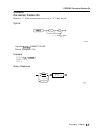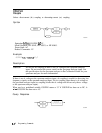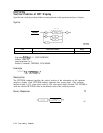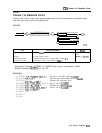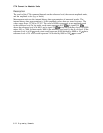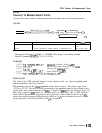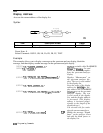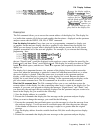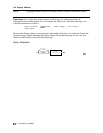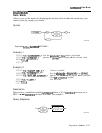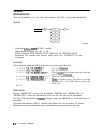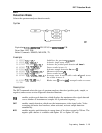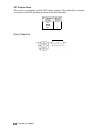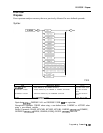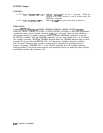
DA Display Address
Restores the display address.
LXspla ys the
meSSage
“‘Done”
on the analyzer screen, and
replaces the text
‘Signalfound”
and the blank spaces that were
in the display list. The text
‘Measurement77
remains on
the spectrum analyzer dis-
play and in the display list.
OUTPUT
718;"MOV
DA,D,ADDRESS;"
OUTPUT
718;"PUPA
100,120;TEXT
%Done%;"
Description
The DA command allows you to access the current address of the display list. The display list
is a buffer that contains all of the text and graphics that have been displayed on the spectrum
analyzer screen with the DSPLY, GR, LB, or TEXT commands.
How the display list works: Every time you use a programming command to display text
or graphics on the analyzer display, the text or graphics is also entered into the display list.
While you can change or erase what is displayed on the analyzer screen, the list for screen
graphics accumulates all of the text and graphics. For example, if you execute the following
programming lines:
OUTPUT
718;"PUPA
100,lOO;TEXT
%Signal
found%;"
OUTPUT
718;"PUPA
100,lOO;TEXT
%
%;
"
OUTPUT
718;"PUPA
100,lOO;TEXT
%Done%;"
the text “Signal found” would be displayed on the analyzer screen, and then be erased by the
blank spaces, and then “Done” would be displayed. The display list would save the text “Signal
found,
”
the blank spaces, and the text “Done,
”
in separate (and sequential) locations in the
display list.
The display list is important because the contents of the display list are used to restore the
screen text when the annotation or graticule is turned off and then turned back on, or when
the screen display is plotted. When the screen text is restored on the spectrum analyzer
display, or the screen display is plotted, the entire display list is used. Because the entire
display list is used, there can be some text “flashing” on the spectrum analyzer display or the
plot can contain unwanted text. The DA command can be used to avoid this situation.
What the DA command does: The DA command allows you to save and then restore the
current address of the display list, thus controlling where text is written in the display list. For
example, if you want your program to display the messages “Signal found,” and “Done,” and
you want only the messages that are currently displayed on the spectrum analyzer screen to be
stored in the display list, you would do the following:
1. Save the display address in a variable.
2. Execute the commands that display the first message on the spectrum analyzer display.
When you want to change the message, you would do the following:
1. Execute the commands that put blank spaces over the message (to clear the message from
the analyzer display). You do not need to use blank spaces the clear the previous message
if the number of characters in the new message is equal to or greater than the original
message.
2. Copy the display address from the variable back into DA (this recalls the previous display
address).
3. Execute the commands that display the new message on the spectrum analyzer display.
Programming Commands 5-125



